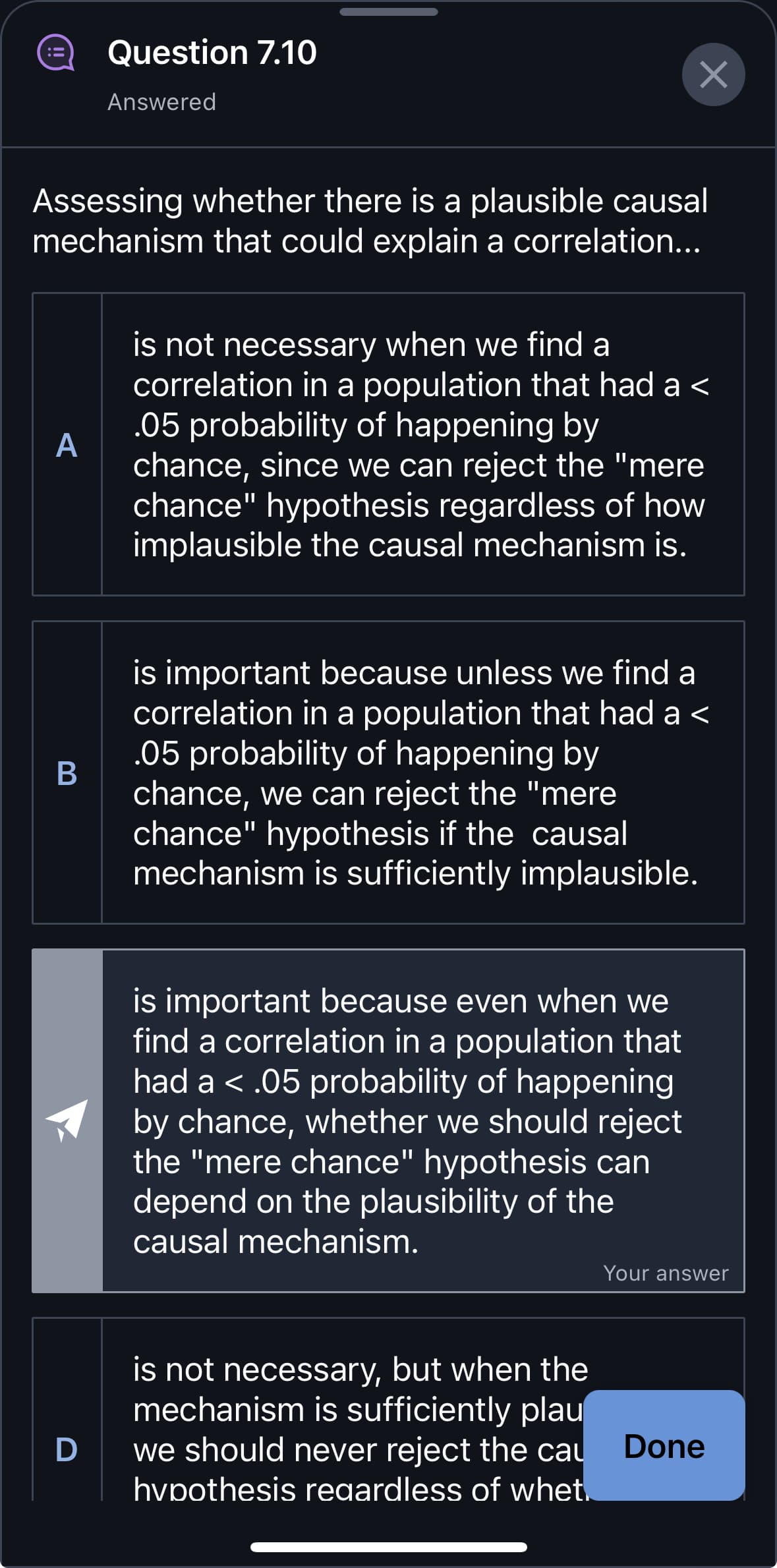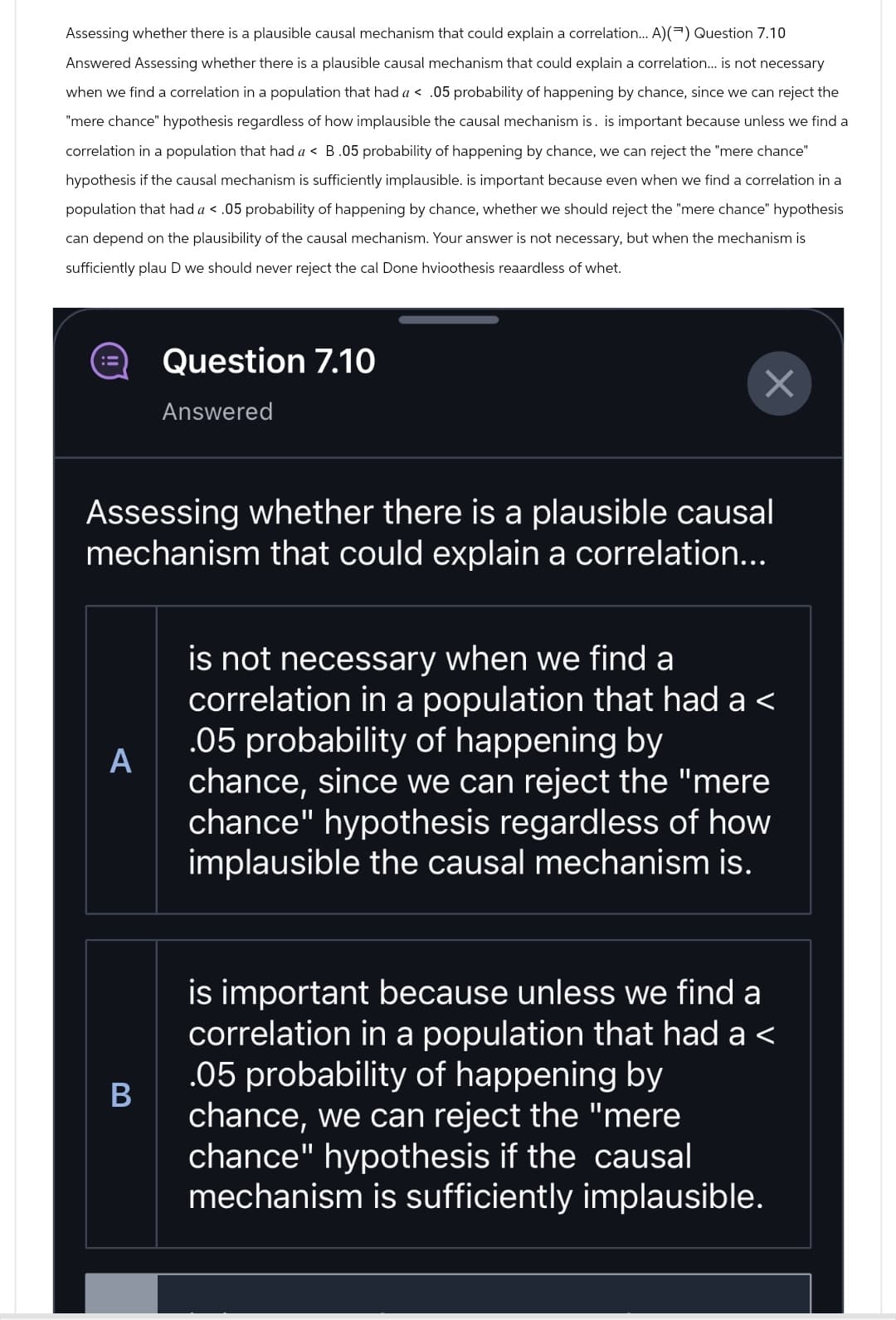Assessing whether there is a plausible causal mechanism that could explain a correlation... A is not necessary when we find a correlation in a population that had a < .05 probability of happening by chance, since we can reject the "mere chance" hypothesis regardless of how implausible the causal mechanism is. B D is important because unless we find a correlation in a population that had a < .05 probability of happening by chance, we can reject the "mere chance" hypothesis if the causal mechanism is sufficiently implausible. is important because even when we find a correlation in a population that had a < .05 probability of happening by chance, whether we should reject the "mere chance" hypothesis can depend on the plausibility of the causal mechanism. Your answer is not necessary, but when the mechanism is sufficiently plau we should never reject the cau hypothesis regardless of whet. Done
Assessing whether there is a plausible causal mechanism that could explain a correlation... A is not necessary when we find a correlation in a population that had a < .05 probability of happening by chance, since we can reject the "mere chance" hypothesis regardless of how implausible the causal mechanism is. B D is important because unless we find a correlation in a population that had a < .05 probability of happening by chance, we can reject the "mere chance" hypothesis if the causal mechanism is sufficiently implausible. is important because even when we find a correlation in a population that had a < .05 probability of happening by chance, whether we should reject the "mere chance" hypothesis can depend on the plausibility of the causal mechanism. Your answer is not necessary, but when the mechanism is sufficiently plau we should never reject the cau hypothesis regardless of whet. Done
MATLAB: An Introduction with Applications
6th Edition
ISBN:9781119256830
Author:Amos Gilat
Publisher:Amos Gilat
Chapter1: Starting With Matlab
Section: Chapter Questions
Problem 1P
Related questions
Question

Transcribed Image Text:Question 7.10
Answered
Assessing whether there is a plausible causal
mechanism that could explain a correlation...
A
is not necessary when we find a
correlation in a population that had a <
.05 probability of happening by
chance, since we can reject the "mere
chance" hypothesis regardless of how
implausible the causal mechanism is.
B
D
is important because unless we find a
correlation in a population that had a <
.05 probability of happening by
chance, we can reject the "mere
chance" hypothesis if the causal
mechanism is sufficiently implausible.
is important because even when we
find a correlation in a population that
had a < .05 probability of happening
by chance, whether we should reject
the "mere chance" hypothesis can
depend on the plausibility of the
causal mechanism.
Your answer
is not necessary, but when the
mechanism is sufficiently plau
we should never reject the cau
hypothesis regardless of whet.
Done

Transcribed Image Text:Assessing whether there is a plausible causal mechanism that could explain a correlation... A)() Question 7.10
Answered Assessing whether there is a plausible causal mechanism that could explain a correlation... is not necessary
when we find a correlation in a population that had a < .05 probability of happening by chance, since we can reject the
"mere chance" hypothesis regardless of how implausible the causal mechanism is. is important because unless we find a
correlation in a population that had a < B.05 probability of happening by chance, we can reject the "mere chance"
hypothesis if the causal mechanism is sufficiently implausible. is important because even when we find a correlation in a
population that had a < .05 probability of happening by chance, whether we should reject the "mere chance" hypothesis
can depend on the plausibility of the causal mechanism. Your answer is not necessary, but when the mechanism is
sufficiently plau D we should never reject the cal Done hvioothesis reaardless of whet.
Question 7.10
Answered
Assessing whether there is a plausible causal
mechanism that could explain a correlation...
A
is not necessary when we find a
correlation in a population that had a <
.05 probability of happening by
chance, since we can reject the "mere
chance" hypothesis regardless of how
implausible the causal mechanism is.
B
is important because unless we find a
correlation in a population that had a <
.05 probability of happening by
chance, we can reject the "mere
chance" hypothesis if the causal
mechanism is sufficiently implausible.
☑
Expert Solution
This question has been solved!
Explore an expertly crafted, step-by-step solution for a thorough understanding of key concepts.
This is a popular solution!
Trending now
This is a popular solution!
Step by step
Solved in 3 steps

Recommended textbooks for you

MATLAB: An Introduction with Applications
Statistics
ISBN:
9781119256830
Author:
Amos Gilat
Publisher:
John Wiley & Sons Inc

Probability and Statistics for Engineering and th…
Statistics
ISBN:
9781305251809
Author:
Jay L. Devore
Publisher:
Cengage Learning

Statistics for The Behavioral Sciences (MindTap C…
Statistics
ISBN:
9781305504912
Author:
Frederick J Gravetter, Larry B. Wallnau
Publisher:
Cengage Learning

MATLAB: An Introduction with Applications
Statistics
ISBN:
9781119256830
Author:
Amos Gilat
Publisher:
John Wiley & Sons Inc

Probability and Statistics for Engineering and th…
Statistics
ISBN:
9781305251809
Author:
Jay L. Devore
Publisher:
Cengage Learning

Statistics for The Behavioral Sciences (MindTap C…
Statistics
ISBN:
9781305504912
Author:
Frederick J Gravetter, Larry B. Wallnau
Publisher:
Cengage Learning

Elementary Statistics: Picturing the World (7th E…
Statistics
ISBN:
9780134683416
Author:
Ron Larson, Betsy Farber
Publisher:
PEARSON

The Basic Practice of Statistics
Statistics
ISBN:
9781319042578
Author:
David S. Moore, William I. Notz, Michael A. Fligner
Publisher:
W. H. Freeman

Introduction to the Practice of Statistics
Statistics
ISBN:
9781319013387
Author:
David S. Moore, George P. McCabe, Bruce A. Craig
Publisher:
W. H. Freeman